
Since the hard drive is not just an electronic device, but an electromechanical device, strong vibration and shock have been and remain its main enemies. But if the vibration effect leads to a decrease in the performance of the hard drive, which is explained by the deviation of the head unit from the specified trajectory and the re-initialization of the positioning procedure, then even a sufficiently strong push (not to mention a fall) can provoke a complete failure of the drive. Why are HDDs so delicate and what measures are taken by manufacturers of hard drives to improve their reliability? Let's try to figure it out.
Strikes of Fate: Why Are Hard Drives So Fragile?
First of all, let's remember how a hard drive works. Inside the HDD is a set of thin metal plates (in common parlance - "pancakes"), covered with a layer of ferromagnet - a substance that can retain magnetization for a long time even in the absence of an external magnetic field. These plates rotate at a tremendous speed - from 5400 rpm or more, moving relative to the head assembly, which consists of several rods, driven by the so-called voice coils.
On the tip of each rod, there are writing heads and readout sensors. The writing heads are designed to change the direction of the magnetization vectors of discrete areas of the ferromagnetic coating (magnetic domains) in accordance with commands from the HDD controller. In this case, each domain encodes one bit of information, assuming a logical value "0" or "1" depending on the direction of the magnetization vector.

The operation of the reading modules of modern hard drives is based on a giant magnetoresistive effect: the electrical resistance of the sensor changes under the influence of the magnetic field of the domains of the ferromagnetic layer, which is recorded by the HDD controller, which, in turn, interprets the increase or decrease in resistance relative to a given level as a logical zero or one ...
To achieve a high recording density, the magnetic heads had to be made extremely small, because the width of the tracks on the magnetic plate depends on their dimensions. The size of the writing module in modern hard drives does not exceed 120 nanometers, and the reading module - 70 nanometers.
 Comparison of the sizes of the beeping and reading heads of the hard disk and the edge of a 10-cent coin
Comparison of the sizes of the beeping and reading heads of the hard disk and the edge of a 10-cent coin
It was thanks to this miniaturization that the data recording density was brought to an impressive figure of 1 Tbit / inch 2and this is through the traditional CMR method. However, this approach has a side effect. As the size of the magnetic heads was significantly reduced, the strength of the magnetic field they created decreased, which forced engineers to significantly reduce the distance between the heads and the surface of the magnetic plates.
When the HDD is functioning, the magnetic heads hover above the surface of the pancakes at a height of only about 12-15 nanometers, and this is achieved due to the screen effect: an air cushion is formed under each boom, as if under the wing of an airplane taking off, providing the necessary lift. It is easy to guess that the magnetic plates themselves should be perfectly smooth and not have any irregularities. This is true: the height difference on the surface of each plate does not exceed 0.6 nanometers. Incredible precision!

However, this design has one very significant drawback: the hard disk is extremely vulnerable to shock during operation. Shock resistance of modern consumer and enterprise-class drives reaches 300-350G in 2ms at rest and only 30-50G in 2ms in read / write mode.
This wide variation is due to the fact that while the drive is unplugged, the head assembly remains parked. Consider the photo below: each bracket receives an additional fixation point, resting on plastic pylons in the parking area, and the heads themselves do not touch the plastic, but hang over it. In this state, they are not afraid of strong vibrations or even shocks.

In working condition, the HDD actuator is deprived of additional support, therefore, an impact of sufficient force, the vector of which will be directed perpendicular to the plane of the disk (or at a slight angle to the perpendicular axis), will inevitably lead to contact between the heads and magnetic plates. This process can be schematically depicted as follows.
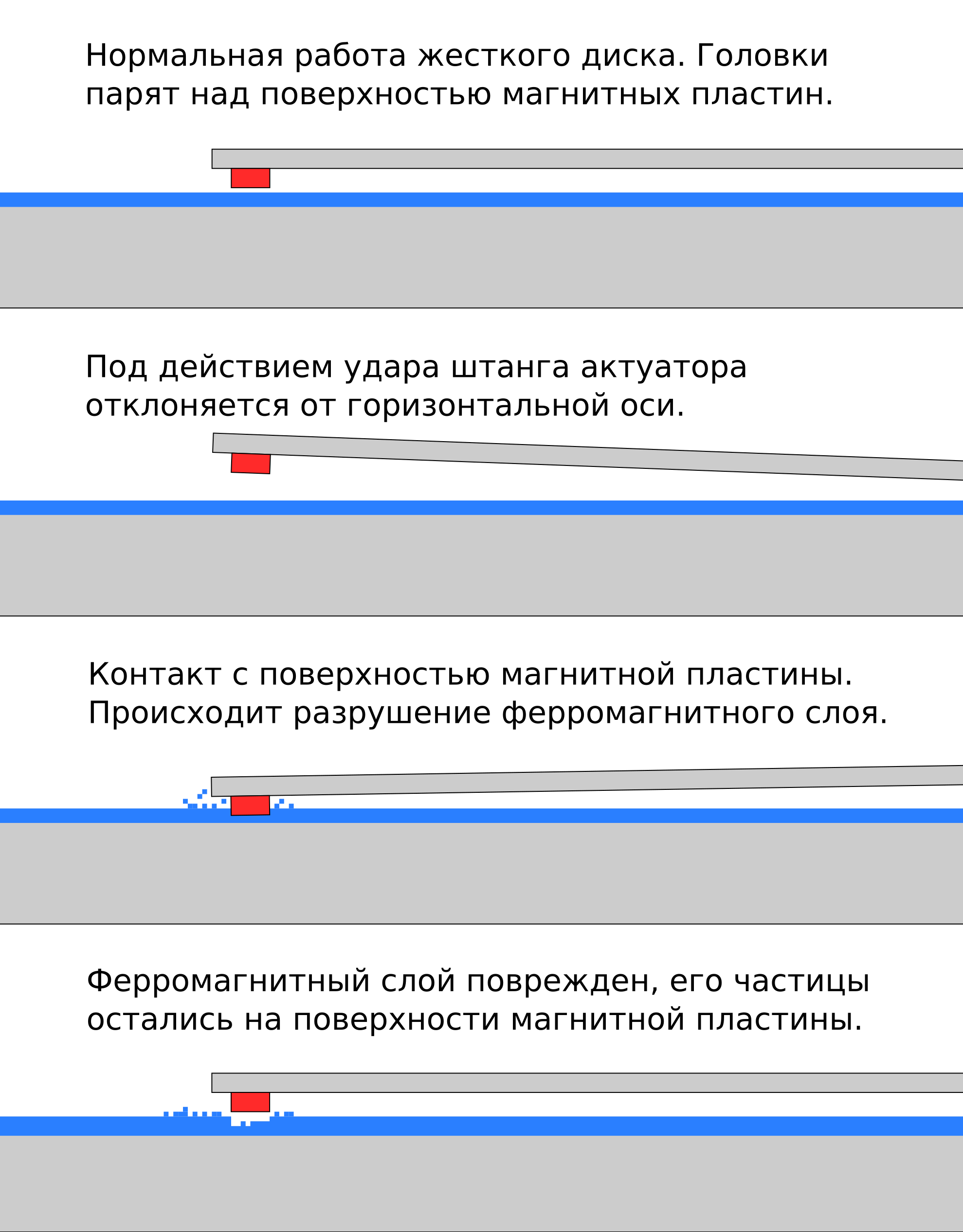
Above is the most successful scenario for the development of events: due to the miniature size of the heads and the huge rotation speed of the magnetic plates, the writing and reading modules with a high degree of probability will simply come off the bracket and the hard drive will instantly become unusable. If you are still lucky and the matter was limited only to the appearance of scratches on the ferromagnetic layer, you should not think that in this case you will be able to get rid of a few broken clusters. Alas, the hard disk will start to slowly but surely "die", and the number of read / write errors will multiply every day. And that's why.
Problem number 1: ferromagnetic particles remain on the surface of magnetic plates
Although the Winchester pancakes rotate at a tremendous speed, the fragments of the ferromagnetic layer will not go anywhere: they are too small and light, so that the magnetic field of the domains will be quite enough to withstand centrifugal force and hold the smallest particles. Their very presence on the surface of magnetic platters is fraught with read / write errors even if they do not directly touch the heads themselves.
Problem number 2: ferromagnetic particles play the role of an abrasive
Since the distance between the surface of the magnetic plates and the heads is extremely small, microscopic particles of the ferromagnet will inevitably touch them, gradually grinding away like sandpaper. And the surface of the pancakes itself will become more and more scratched, which will be expressed in a gradual increase in the number of broken clusters.
Problem # 3: the sensing sensor will heat up due to frictional force
When particles of a ferromagnet moving at high speed touch the sensor, the latter, due to its microscopic size, heats up instantly, due to which the resistance in the sensor increases sharply and the data from the read head is interpreted incorrectly. This leads to numerous read errors even at the stage when the read head is still intact.
Damage to the head unit is by no means the only (albeit the most severe) consequence of impact on a hard drive. Magnetic plate bearings are also at risk. A strong impact of the ball on the bearing cage can lead to its deformation, damage to the ball itself or the raceway (sometimes to all of the above). Although the HDD will continue to work, the damaged bearing will vibrate strongly, which will negatively affect the performance of the hard drive and lead to premature wear of the spindle motor.
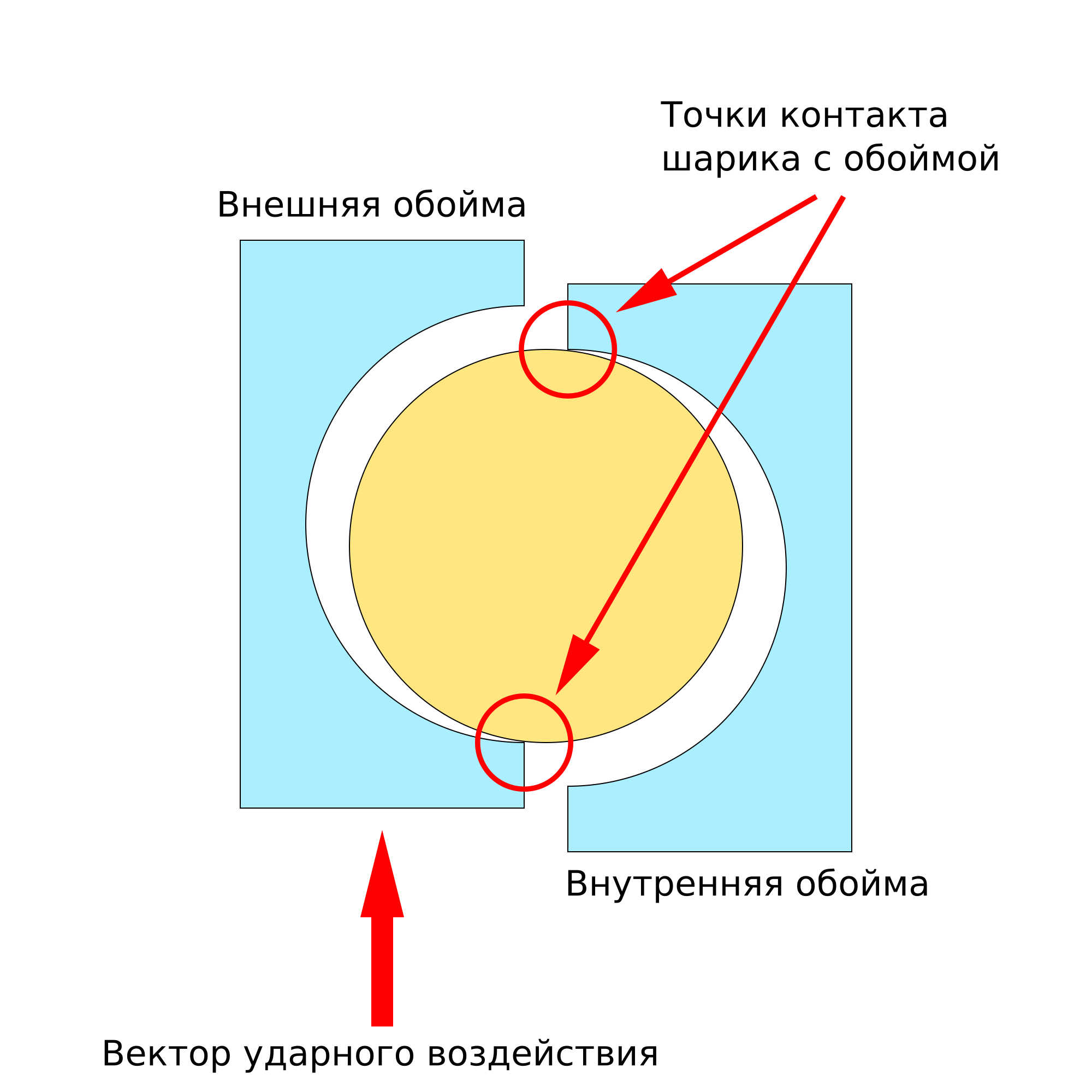
And finally, the least of the evils is the slippage of the magnetic plates in the package, when one or more pancakes, having received additional acceleration, rotate relative to their fellows. At the same time, it is this problem that occurs much less often than all those listed above, and has a minimal impact on the HDD performance.
Key Approaches to HDD Shock Protection
Although the history of hard drives goes back more than 64 years, hard drive manufacturers took their hard drive seriously only in 1997. This attitude looks frivolous, but in fact it is quite simple to explain the delay.
In the late 90s, the fashion for compact external HDDs was just starting to gain momentum. The starting point can be called the emergence of IBM Microdrive, released in 1999, which we wrote about earlier in the material on external data storage . Meanwhile, it is portable drives that are most vulnerable.
 Opened IBM Microdrive vs. 50 euro cent coin
Opened IBM Microdrive vs. 50 euro cent coin
It is quite difficult to imagine a situation when an internal hard drive, being already installed in a PC, can fail from a blow (unless you deliberately hit its body with a sledgehammer). The massive Full Tower frame is quite capable of providing adequate protection for the hard drives installed inside, effectively absorbing kinetic energy. If, for example, you accidentally hit the computer with your foot, the impact on the hard drive will be much weaker than 30G in 2 ms (and even less than 10G in 2 ms - this is how much HDDs released at the turn of the XX-XXI centuries could withstand), so what to do here any special measures have no practical sense.
Laptop cases of those times were also not like modern ultra-thin models: laptops of the 90s provided quite decent protection for the hard drives installed in them, albeit not as reliable as stationary computers.
 Older laptops were much more durable. On the photo - Siemens Nixdorf PCD-5ND
Older laptops were much more durable. On the photo - Siemens Nixdorf PCD-5ND
On the contrary, in portable data storage devices HDD is separated from the outside world only by a thin plastic case, unable to absorb all the impact energy. How, in this case, the hard drive can be protected from damage?
IBM itself was the pioneer in the development of shock protection systems. It was the engineers of the American corporation who created the technology with the uncomplicated name Ramp Load / Unload, which today is used everywhere in every hard drive, regardless of the price category. We are talking about the above-mentioned parking area and a system of plastic pylons that fix the rods of the head unit while the HDD is disconnected from the power supply. For its time, such a solution became truly innovative, making it possible to increase the shock resistance of hard drives at rest several times.
 In older models of hard drives, the head block parking system was basically absent.
In older models of hard drives, the head block parking system was basically absent.
Samsung's ShockSkinBumper (SSB) technology should be mentioned among the same simple, but quite effective measures. As you might guess from the name, the essence of the innovation lies in the presence of a bumper built into the body of the drive, represented by a thin silicone rim that fits the metal cover of the hard drive.
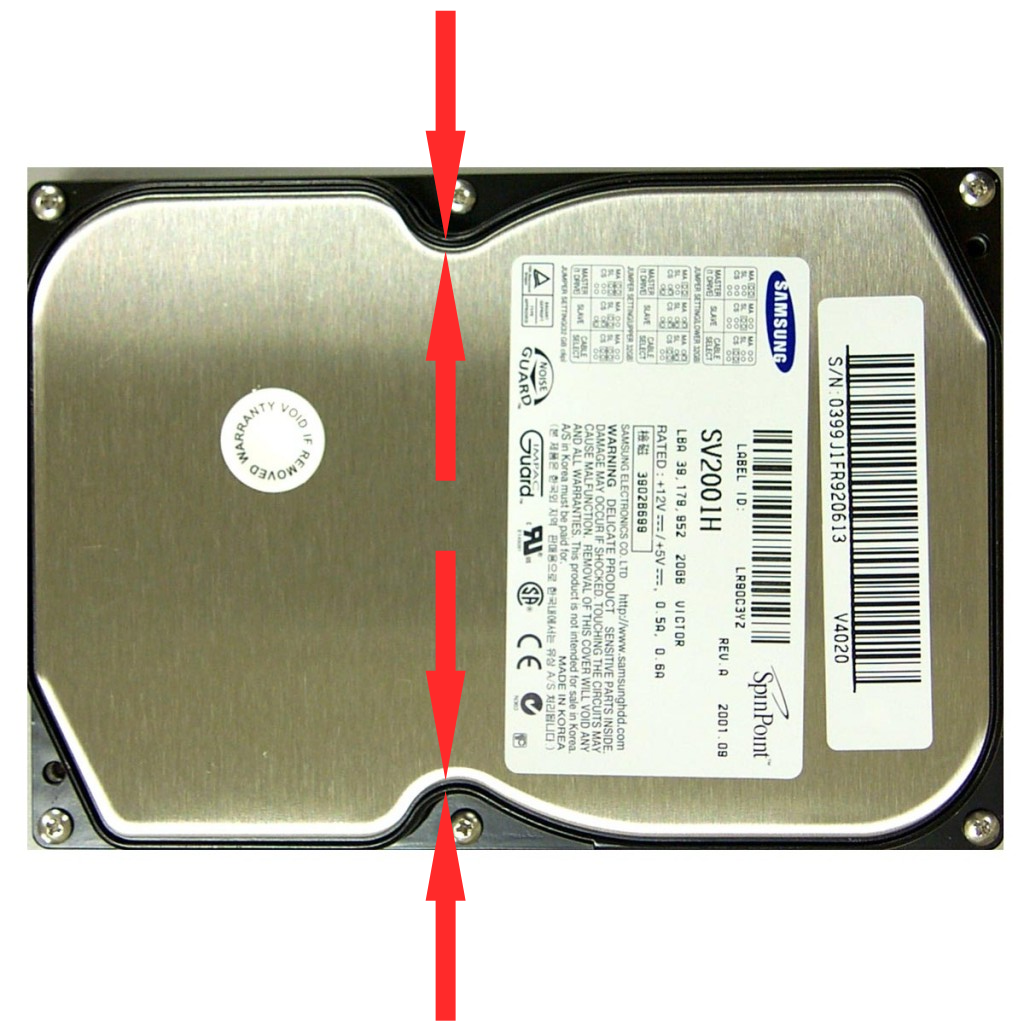 If you look closely, you can see the edge of the Samsung ShockSkinBumper
If you look closely, you can see the edge of the Samsung ShockSkinBumper
According to Samsung, the bumper proved to be extremely effective and helped to reduce by three times the overload that affects the internal components of the hard drive when hit or dropped, significantly increasing its shock resistance at rest.
As for the problem of bearing damage, initially the manufacturers of hard drives experimented with the shape of the cage and the dimensions of the rolling elements, trying to find the optimal balance between the size of the contact area of the balls with the tracks (the larger it is, the better the bearing tolerates shock) and the resistance arising from the friction of their surfaces against each other. Subsequently, the conventional rolling bearings were replaced by more advanced hydrodynamic plain bearings, in which the rotation of the spindle shaft occurs in a layer of fluid held inside the sleeve due to the pressure difference created during engine operation. This approach helped not only to increase the shock resistance of hard drives, but also to reduce the level of vibration and noise generated by them during operation, and at the same time to increase their fault tolerance.
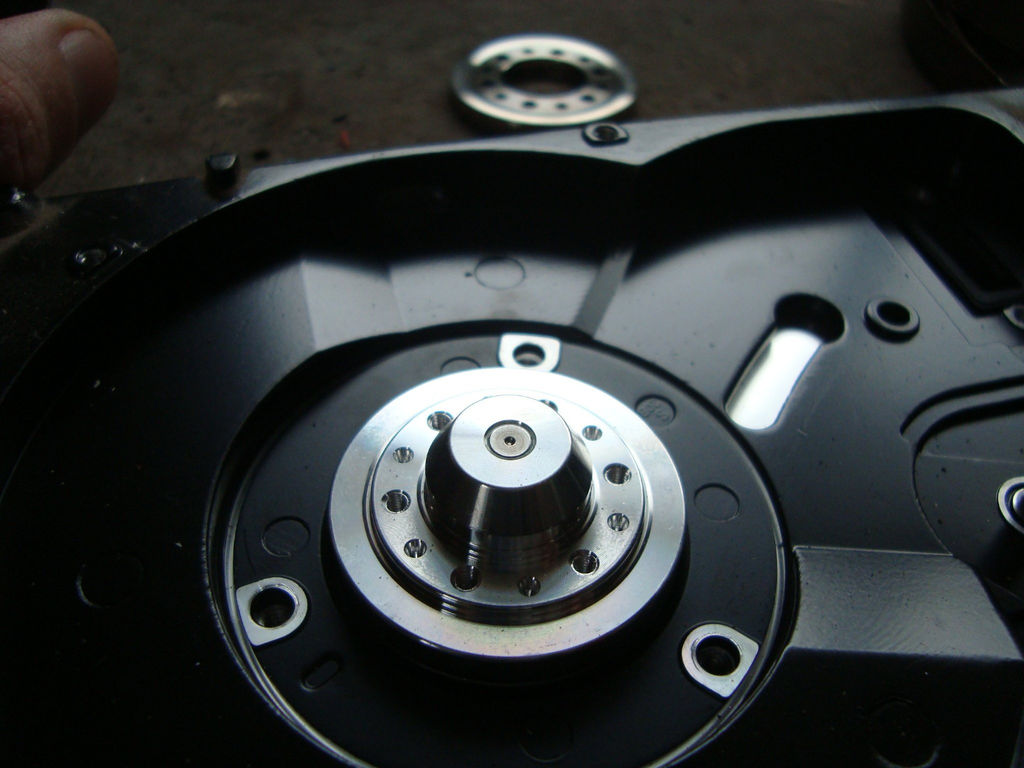 No balls - no problems
No balls - no problems
However, the main thing that all manufacturers of hard drives, without exception, tried to achieve, was to maximally protect the head unit from shock. The pioneer in this field was the Quantum company, which introduced back in 1998 its own system for protecting hard drives, the Quantum Shock Protection System (SPS), the first practical implementation of which was seen in the Fireball EL hard drives.
 Quantum Fireball EL Shock-Resistant 2.5GB Hard Drive
Quantum Fireball EL Shock-Resistant 2.5GB Hard Drive
In total, the SPS enhancement package included 14 technological innovations aimed at absorbing and compensating for actuator shock. Already in 1999, the modified SPS II system saw the light, and the Fireball Ict naturally became the first disc with the support of the updated anti-shock technology.
In parallel with Quantum, research in the field of protecting hard drives from shocks and falls was carried out by their direct competitor - Maxtor Corporation. The result of the efforts of the company's engineers is the ShockBlock technology, which has found application in the drives of the "diamond" line of DiamondMax.
 Maxtor DiamondMax Plus 21 Hard Drive
Maxtor DiamondMax Plus 21 Hard Drive
Samsung was also actively involved in improving the head block: the patented technology of the Korean corporation, called Impact Guard, included a number of improvements in the design of the bearing brackets, suspension and stabilization system. Western Digital did not lag behind: a set of Shock Guard enhancements, specially designed for Caviar-branded hard drives, helped to bring the shock resistance of the company's hard drives to values comparable to those of modern HDDs.
It makes no sense to thoroughly describe each of the listed technologies: design solutions designed to increase the shock resistance of hard drives, in one way or another, repeated each other, although they had differences in implementation methods. Let's list the main techniques that HDD manufacturers have adopted to increase their shock resistance:
- absorption of kinetic energy by structural elements of the body;
- reducing the stiffness of the brackets by increasing their rigidity;
- installation of a shock-absorbing suspension of the heads, which minimizes damage to the read / write modules and the ferromagnetic layer in contact between them.
The last point requires additional clarification. During the tests, it was found that the degree of destruction of the ferromagnetic coating, as well as the probability of detachment of the magnetic heads, depends not so much on the force of the impact as on how exactly the read and write modules come into contact with the surface of the pancakes. The most extensive damage is naturally observed when the head hits the plate with an edge or corner.
The improved suspension mechanism made it possible to achieve that the magnetic heads are in contact with the plates flat, with their entire surface, as shown in the diagram below.

Since their surfaces are almost perfectly smooth, the probability of chipping (and all the more complete detachment of the magnetic heads) is noticeably reduced, and under the most favorable circumstances, both the ferromagnetic coating and the modules themselves remain intact.
Indestructible drives for sports and outdoor activities
Although these measures have helped to significantly improve the reliability of hard drives, the miracle never happened. Whatever one may say, but you can't argue with physics, and if the same Maxtor at one time was able to bring the shock resistance of hard drives at rest to an impressive 1000G in 2 ms, albeit on test samples, then it turned out to provide a comparable level of protection for the head unit during HDD operation. almost impossible.
However, with the cheapening of flash memory, the market situation has changed radically, and the need for shockproof external hard drives has practically disappeared, as they have been replaced by solid-state drives. Due to technological features, SSDs are in a much more advantageous position: they do not contain moving components, which means that all that needs to be achieved in order to get an impact-resistant device at the output is to create a sufficiently durable case that can provide an adequate level of protection for the printed circuit board. boards, which is much easier compared to the development of dynamic compensation systems. However, it is better to see once than hear a hundred times. Just look at this photo.

A touring carabiner strapped to a backpack hangs a SanDisk Extreme Portable SSD, a compact solid state drive aimed at outdoor enthusiasts. If you treat a regular HDD in this way, then it will almost certainly become completely unusable after a couple of marches. However, the SSD does not threaten a breakdown: thanks to the rubber-plastic case, it is able to withstand overloads up to 1500G in 2 ms, which is 5 times more than the shock resistance of a hard drive at rest, and almost 30 times more than the shock resistance of a HDD when reading / writing data. At the same time, the 1500G indicator is a constant and does not change in any way, even when you are working with a solid state drive.
In addition to being able to withstand significant overloads, the SanDisk Extreme Portable SSD is also highly resistant to dust and moisture to an IP55 standard.

The first digit of the index indicates that the SSD has a dustproof design: although a certain amount of fine particles can get inside its case, this will not affect the device's performance in any way. The second number indicates that the solid state drive case is able to withstand even strong water jets falling from any direction.
Another interesting feature of this series of drives is connected with water resistance. Please note: the USB Type-C connector, located at the bottom end, does not have a rubber cap, which you usually expect to see on such a device.

A flaw? Not at all. The thing is that the port does not communicate with the internal cavities of the case: it is completely isolated and sealed, so that water that gets into it will not harm the electronic components of the SSD, although the connector will have to be thoroughly dried before use. This approach made it possible to make the solid-state drive even more reliable and durable, because any plugs tend to loosen over time.
In terms of performance, the SanDisk Extreme Portable did not disappoint here, too, with a sustained 550MB / s transfer rate. If this is not enough for you, we recommend paying attention to the Pro version of the device.
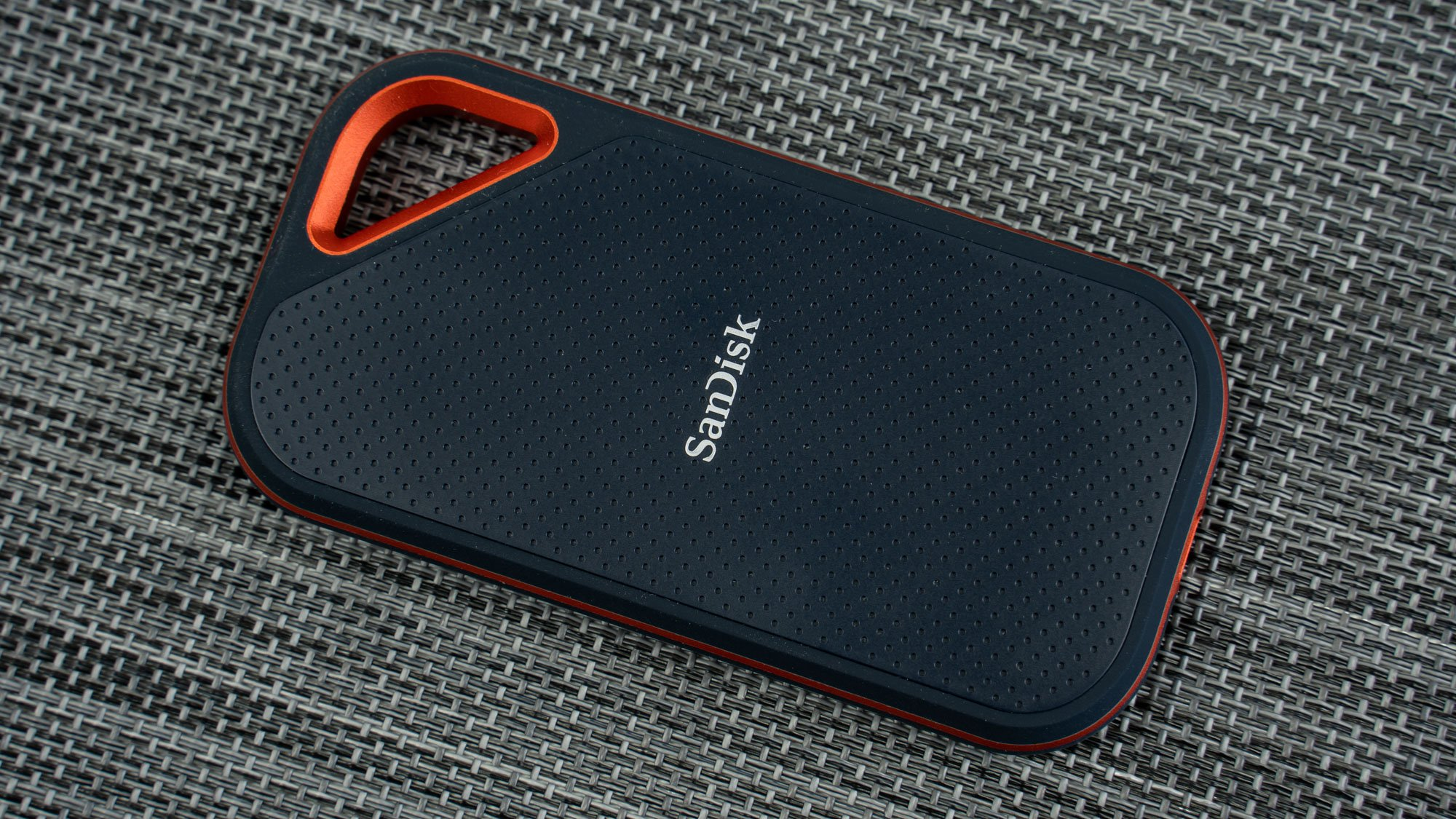
The design of the older drives has slightly changed: an orange side insert and a modified lug shape have made the SSD look more sporty and expressive. But the main difference between the Pro version and the regular version lies in the support of the high-speed USB 3.2 Gen 2 interface, thanks to which the speed of the drive has increased to an impressive 1050 MB / s. At this speed, even transferring 100 GB of data will take no more than 2 minutes.

Want more? This year saw the release of updated versions of the SanDisk Extreme Portable V2. As before, the compact SSD family is split into two lines: Standard and Pro. In terms of protection against shock, dust and water, nothing has changed at all, but their performance has doubled.
SanDisk Extreme Portable V2 adds USB 3.2 Gen 2 and now boasts speeds of 1050 MB / s in read operations and up to 1000 MB / s when writing files. In turn, the SanDisk Extreme Portable Pro V2 will appeal to owners of USB 3.2 Gen 2 x 2 devices: an impressive 2000MB / s makes this SSD the fastest rugged SSD on the market, and allows you to transfer even the most voluminous SSDs in seconds. files that will surely appeal to fans of photography and video filming, travel bloggers, journalists and other content creators.

As an additional bonus, it is necessary to mention the built-in support for hardware encryption AES with a 256-bit key, which is one of the most reliable methods of cryptographic data protection today. So, with the new SanDisk Extreme Portable, you can be 100% confident that your valuable information is safe.